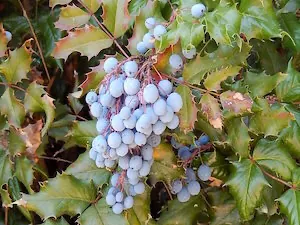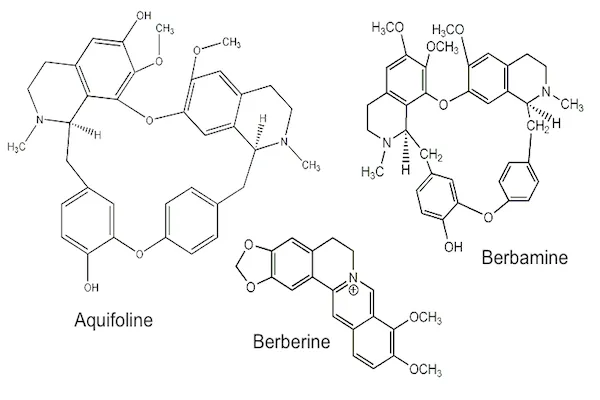Overview of Oregon Grape
Scientific Name: Mahonia aquifolium / Berberis aquifolium
Order: Ranunculales
Family: Berberidaceae
Oregon grape is common throughout California, Oregon, and Washington. Ointments containing extracts from Oregon grape are used in treating skin conditions, such as psoriasis and eczema. Do not confuse with barberry (Berberis vulgaris). The fruit, which are somewhat tart, can be eaten raw.
Strong:
insufficient informationGood:
- Psoriasis, ointments containing Oregon grape appear to be quite effective and one study found that Oregon grape worked well with dithranol [1-6]
Promising:
- Atopic Dermatitis (Eczema), ointments containing Oregon grape may be effective [7-8]
- An ointment containing Oregon grape, Viola tricolor, and Centella asiatica was not effective; however, this ointment may relieve eczema in cold and dry weather [9]
Conflicting (Unclear):
insufficient informationLimited Evidence:
insufficient informationNo Evidence:
insufficient informationNo Clinical Research:
All other conditions.- Allergic Reactions
- Burning
- Itching
- Redness
- Use caution or contact a licensed healthcare practitioner, since there is not enough research on the use of supplements containing Oregon grape.
- Skin contact with Oregon grape has sometimes caused intense pain.
- If you get Oregon grape in your eyes, wash them immediately.
- Oregon grape extracts should not be taken by the mouth.
Although there is not enough research on the use of Oregon grape during pregnancy and breast-feeding, it should not be used. [10-13]
Major:
insufficient informationModerate:
insufficient informationPotential:
insufficient informationOregon grape is not a "drug", the best doses have not been thoroughly established. Make sure to follow the specific product instructions and take as directed on the label, or consult a licensed healthcare practitioner before use.
1. Augustin M, Andrees U, Grimme H, Schöpf E, Simon J. Effects of Mahonia aquifolium ointment on the expression of adhesion, proliferation, and activation markers in the skin of patients with psoriasis. Forsch Komplementarmed. 1999 Apr;6 Suppl 2:19-21. 2. Bernstein S, Donsky H, Gulliver W, Hamilton D, Nobel S, et al. Treatment of mild to moderate psoriasis with Reliéva, a Mahonia aquifolium extract--a double-blind, placebo-controlled study. Am J Ther. 2006 Mar-Apr;13(2):121-6. 3. Gieler U, Von der Weth A, Heger M. Mahonia aquifolium: a new type of topical treatment for psoriasis. Journal of Dermatological Treatment. 1995 Jan 1;6(1):31-4. 4. Gulliver WP, Donsky HJ. A report on three recent clinical trials using Mahonia aquifolium 10% topical cream and a review of the worldwide clinical experience with Mahonia aquifolium for the treatment of plaque psoriasis. Am J Ther. 2005 Sep-Oct;12(5):398-406. 5. Jong MC, Ermuth U, Augustin M. Plant-based ointments versus usual care in the management of chronic skin diseases: a comparative analysis on outcome and safety. Complement Ther Med. 2013 Oct;21(5):453-9. 6. Wiesenauer M, Lüdtke R. Mahonia aquifolium in patients with psoriasis vulgaris - an intraindividual study. Phytomedicine. 1996 Nov;3(3):231-5. 7. Donsky H, Clarke D. Reliéva, a Mahonia aquifolium extract for the treatment of adult patients with atopic dermatitis. Am J Ther. 2007 Sep-Oct;14(5):442-6. 8. Jong MC, Ermuth U, Augustin M. Plant-based ointments versus usual care in the management of chronic skin diseases: a comparative analysis on outcome and safety. Complement Ther Med. 2013 Oct;21(5):453-9. 9. Klövekorn W, Tepe A, Danesch U. A randomized, double-blind, vehicle-controlled, half-side comparison with a herbal ointment containing Mahonia aquifolium, Viola tricolor and Centella asiatica for the treatment of mild-to-moderate atopic dermatitis. Int J Clin Pharmacol Ther. 2007 Nov;45(11):583-91. 10. Fetrow CW, Avila JR. The complete guide to herbal medicines. Spring House, PA, USA: Springhouse Corporation; 2000. 11. Gieler U, Von der Weth A, Heger M. Mahonia aquifolium: a new type of topical treatment for psoriasis. Journal of Dermatological Treatment. 1995 Jan 1;6(1):31-4. 12. Gruenwald J, Brendler T, Jaenicke C, editors. PDR for herbal medicines. 4th ed. Montvale, NJ, USA: Thomson Healthcare; 2007. 13. Wiesenauer M, Lüdtke R. Mahonia aquifolium in patients with psoriasis vulgaris - an intraindividual study. Phytomedicine. 1996 Nov;3(3):231-5. 14. Afendi FM, Okada T, Yamazaki M, Hirai-Morita A, Nakamura Y, Nakamura K, Ikeda S, Takahashi H, Altaf-Ul-Amin M, Darusman LK, Saito K, Kanaya S. KNApSAcK family databases: integrated metabolite-plant species databases for multifaceted plant research. Plant Cell Physiol. 2012 Feb;53(2):e1.

